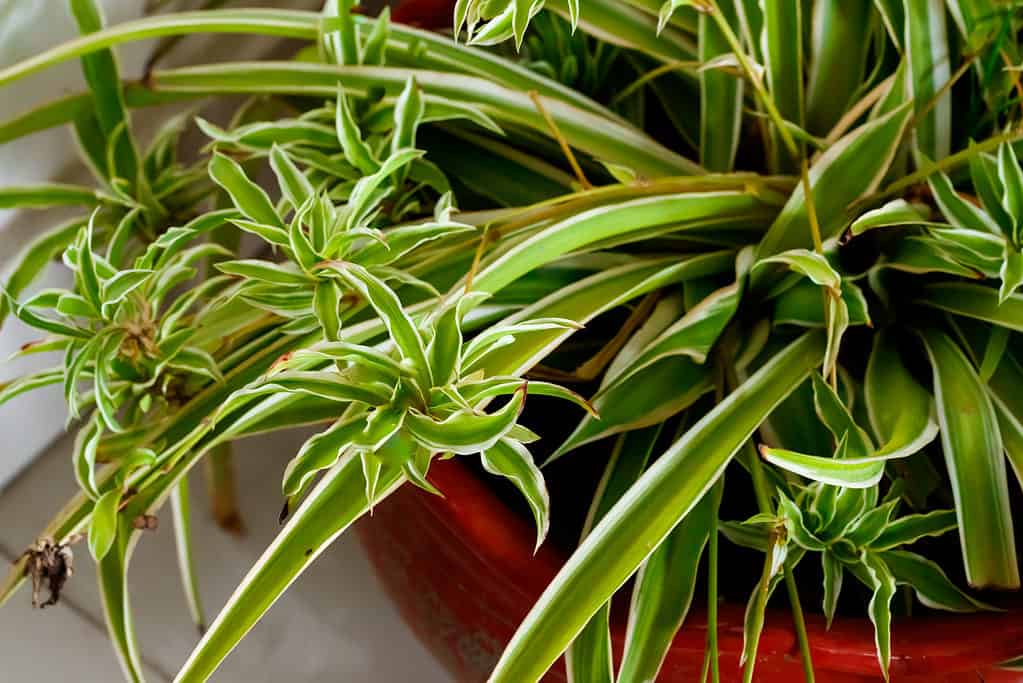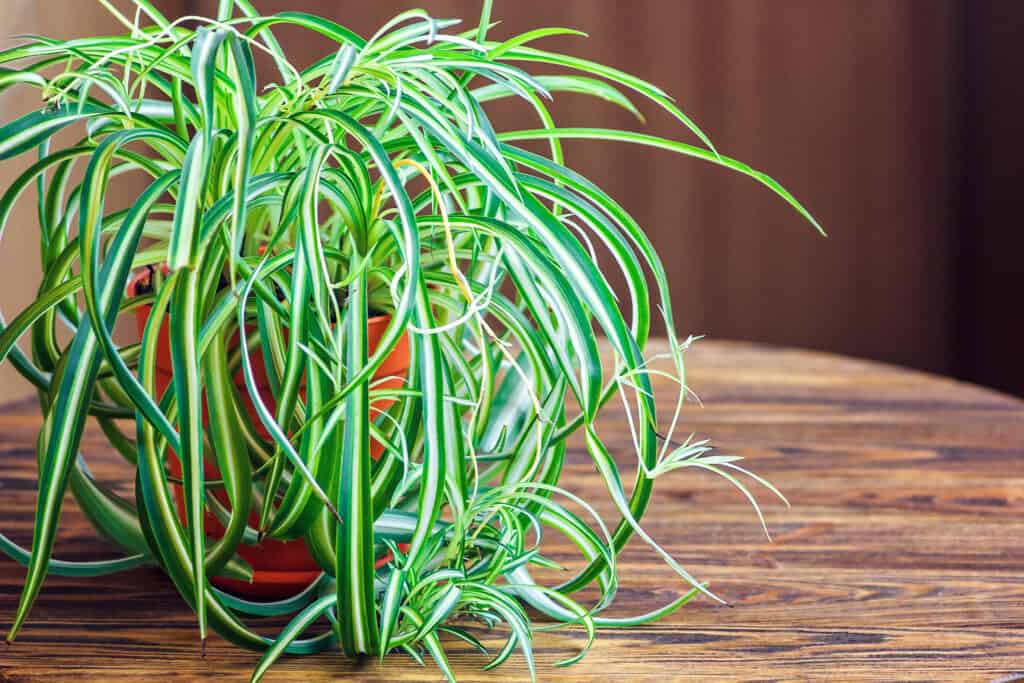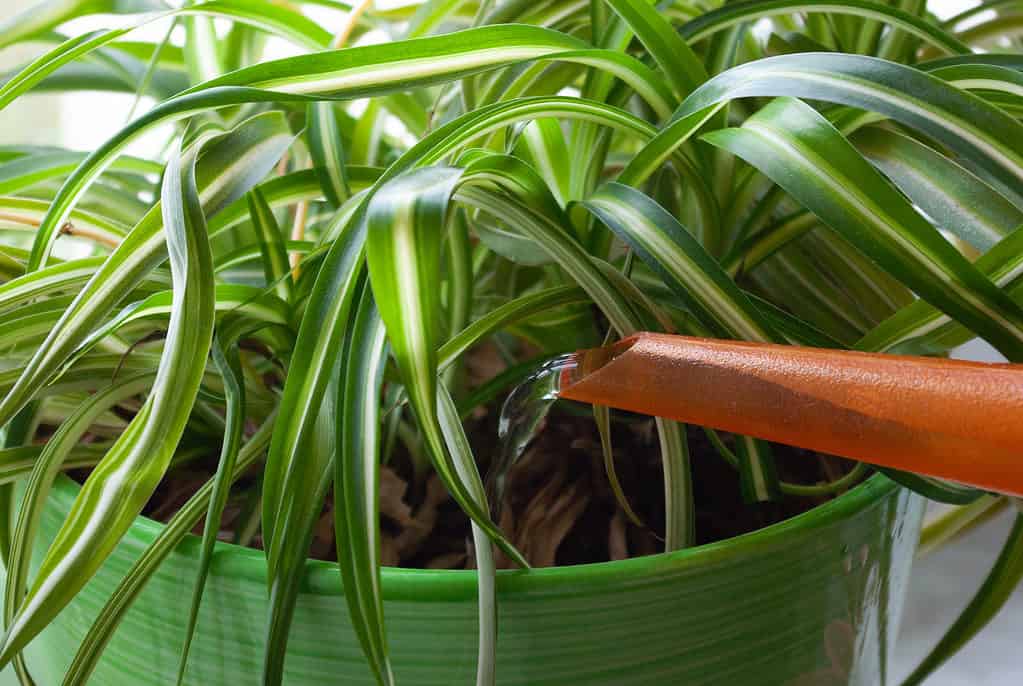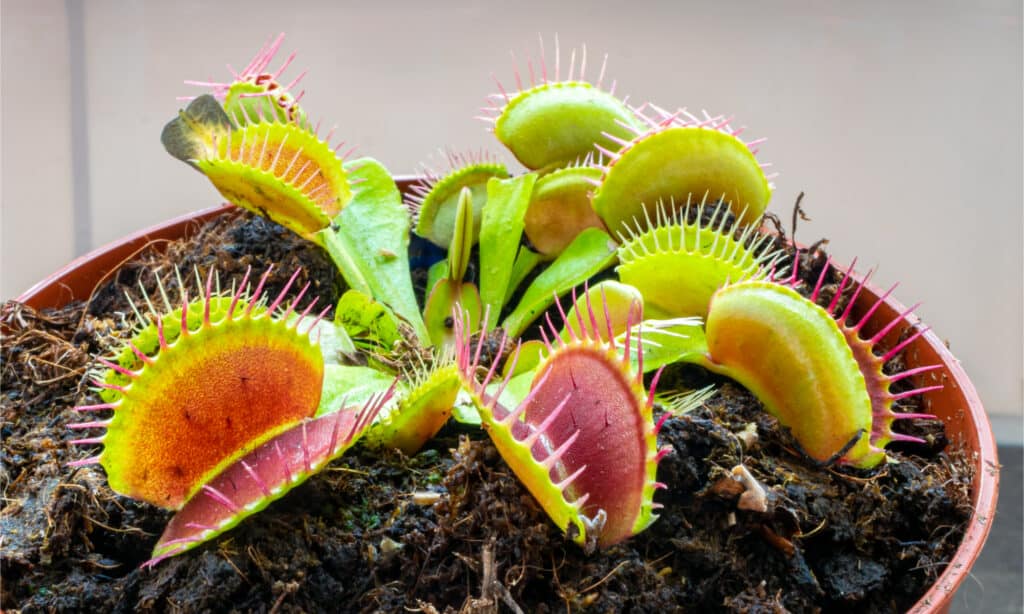While many of us have seen photographs of gorgeous spider plants, most people are unaware that these plants bloom–they may actually produce blossoms. Spider plants are capable of producing lovely little white blossoms if given the correct care.
But what if a spider plant refuses to bloom? What can be done to encourage flower growth? Flower growth is particularly important for spider plant owners who want to propagate more plants. These flowers turn into spiderettes that can be cut off and planted as individual plants.
Let’s take a look at what spider plant flowers are and how to encourage their growth.
What is a Spider Plant?
Contrary to popular belief, spiders are not frequently found on or drawn to the spider plant. Instead, the long, spindly leaves that emerge from the plant’s base are what give it its name. Instead of calling the plant by its formal name, Chlorophytum comosum, many people choose to call it a spider plant or airplane plant because of its lengthy leaves, which can resemble spider legs.
In order to maintain clean and fresh air in their homes, people frequently grow spider plants. Compared to other plant species, the spider plant produces oxygen remarkably efficiently. As a result, your home’s air may be cleansed and harbor less carbon monoxide, formaldehyde, and other potentially harmful substances. A spider plant is frequently used as a decoration in homes with curious kids or boisterous pets due to its nontoxicity.

Spider plants can flower, and those flowers will eventually turn into spiderettes (pictured).
©iStock.com/niuniu
Do Spider Plants Grow Flowers?
It is true that spider plants can produce flowers. Given that spider plants require so little care and that these blossoms are usually quite little and fleeting, most people don’t even notice them. The ends of the stems and leaves of your spider plant’s leaves will be covered in tiny white flowers if they decide to bloom. The blossoms will resemble a standard U.S. quarter in size and appear rather modest. The spider plant is far from a flashy bloomer, but its flowers are still quite pretty.
Although this solely depends on your variety of spider plants, some spider plants may develop one or two blooms at the end of a stalk, while other spider plants will create clusters of flowers. These little blossoms are almost entirely white in color, yet depending on how your plant is doing and how healthy it is generally, they could have a slight tinge of yellow or green. These plants will have three to six petals. Petal types with three to six petals are usually long, slender, and symmetrical in both the horizontal and vertical axes.
The blossoms themselves won’t have much of a scent and will wither away rather fast. It’s likely that you won’t see the blossoms on your spider plant until they wilt and drop off the stem if you aren’t paying close attention to it.
Why Do Spider Plants Grow Flowers?
Because they have developed to the point where they can generate blooms, spider plants can sprout blossoms. If you don’t allow spider plants enough time to mature, they will never produce blossoms. Your spider plants are considered mature plants when they first begin to blossom.
It’s pretty easy to observe the spider plants’ growth from a young plant into a fully grown plant. The stems, roots, and leaves will all grow longer and thicker as they near maturity. Additionally, an arching pattern will begin to appear in the leaves. The stalks will also start to become longer, and some older spider plants’ stalks can even go as long as three feet tall, depending on the variety. These plants can only start producing blooms once they reach this stage.
It’s very probable that your spider plants will have matured to this stage and be able to produce flowers if you’ve kept them for a number of years. You don’t want to let your spider plants outgrow their containers since that will prevent them from blossoming. Taking the right actions to allow your spider plants to bloom is all it takes to grow blossoms on them.
When Do Spider Plants Flower?
Predicting when your spider plant will feel motivated to produce blossoms might be challenging because every spider plant is unique. When they are young, some spider plant species constantly bloom, making them a sight to behold for any plant enthusiast. However, after that, they may never again produce blooms. Most other types won’t bloom until they are completely developed and, oddly enough, when they are significantly pot-bound.
When a plant is root-bound or pot-bound, for those who may not be familiar with gardening jargon, it means that the roots no longer have someplace to go and have started to take the shape of the container it is in. It frequently happens when young plants are placed in tiny pots and are never transferred to a larger container to suit the developing root system. They will flower because they think they’re dying and are attempting to reproduce. However, you don’t have to bring your spider plant to the verge of death in order to get it to flower.

If you provide your spider plant (pictured) with the right care, it will grow like a weed and likely flower at some point.
©Bozhena Melnyk/Shutterstock.com
How to Get a Spider Plant to Flower
Let’s get the disappointing news out of the way. You should be ready for the possibility that your spider plant may never produce blossoms if you wish to try and get it to do so. Spider plants are not well recognized for their ability to produce flowers. Depending on where you live, you can have difficulty finding certain spider plant varieties that are more likely to blossom.
Additionally, bear in mind that some spider plant species only produce blossoms when they are young, and after they have passed that age, they will never again do so. This implies that your spider plant could never blossom even though you are giving it the ideal circumstances to do so. With this in mind, you can start making an effort to provide the spider plant with the circumstances necessary for it to have a chance of producing the blossoms that it is capable of. If you chose a spider plant because you can often get away with providing little to no maintenance, then this may not be your greatest choice. Getting your plant to blossom may require much additional care and labor.
Spider Plant Flowering Tips
The spider plant has a few requirements that must be met, much like other blooming plants, if you want it to have any chance of blossoming. One need is that it gets the proper quantity of sunshine. Since spider plants only thrive in indirect sunlight, this might be challenging. Moving the plant about your home in accordance with the seasons is the best approach to overcome this obstacle. This will guarantee that the plant receives as much bright and indirect sunlight as possible during the year. Seasonal variations in the amount of light the spider plant requires imply that it will require more light in the summer and less light in the winter. To meet these demands, you might need to practice a little.
Additionally, make sure your spider plants are receiving a little bit of fertilizer on a regular basis. Unlike many plants, your spider plant may decide it doesn’t want to flower if you use too much fertilizer, opting to produce lush, green leaves instead of flowers. For your spider plant, you should use a 2-4-4 fertilizer or even a 4-4-4 fertilizer. This refers to nitrogen, phosphorus, and potassium per hundredweight of the fertilizer product. The spring season, when your plant may be more likely to flower than during other seasons, may be worth adding a bloom-boosting fertilizer to your plant’s soil if you are really trying to grow flowers from your spider plant.

Regular watering can help a spider plant (pictured) grow and eventually blossom.
©iStock.com/Simplylesia
Improving the Health of Your Spider Plant
Naturally, while attempting to get the plant to blossom, you will need to ensure you are maintaining its health. Your spider plant won’t be able to try to grow blossoms if it is using all of its energy and resources in attempting to survive. The key is to give it everything it needs, so it can direct its energy toward flowering.
You must attend to the plant’s fundamental needs and meet its need for light and a little fertilizer. This includes giving the plant adequate water, keeping it free of pests if it’s outside, and taking care of any issues as soon as you see them.
Originating in South Africa, spider plants have evolved and changed to be able to hold large amounts of water in their stems and roots. This gives them the ability to live with little to no care, but it also makes them particularly susceptible to overwatering. When watering your plant, you should use caution; only provide extra water when it seems necessary. Your plant’s soil should drain well so that it does not become waterlogged.
Although you should still check the leaves and stems to ensure nothing is trying to nibble away at your spider plant, this sort of plant isn’t particularly susceptible to pests. Always be alert for warning signals of infestation and take immediate action with insecticide to address any potential issues. By keeping your plant healthy, you have the best chance of seeing it flower!
Should I Prune Flowers From My Spider Plant?
The choice is entirely up to you. Pruning the blooms is not actually essential because of their short lifespan. Removing blossoms from your spider plant won’t positively or negatively impact its health. That being said, if you are fortunate enough to have a spider plant that has flowered, you should make the most of it while it is in bloom. As we mentioned earlier, these little flowers are unassuming but quite pretty!
You may also collect seeds from the flower blossoms if you wait until the green pods have turned brown. You can propagate and multiply spider plants with these seeds, and they will blossom again.
Spider plants are quite beautiful and useful, even if they do not flower. However, caring for one’s spider plant properly and providing ongoing maintenance will result in improved plant health, which will always lead to flowering. If your spider plant has bloomed, that means you’re taking care of it correctly!
Do you want to learn even more about the incredible and resilient spider plant? Take a look at our complete guide to spider plants here!
What Other Indoor Houseplants Are Pet-Friendly?

The carnivorous Venus flytrap can help control flies in the home, while also being non-toxic to pets.
©Menno van der Haven/Shutterstock.com
It’s true–spider plants are non-toxic, so are an excellent choice to own if you have pets like cats or dogs that enjoy tasting. There are other popular house plants that are equally safe to have around your pets, so are considerations as safe alternatives. Below are 5 plants that are pet-safe.
- African Violets (Saintpaulia)–These flowering plants have been popular in homes for decades due to the lovely flowers they produce, as well as their low maintenance, as they are able to bloom in low light. Best of all, they will not hurt your pets if they decide to take a nibble.
- Chinese Money Plants (Urticaceae)–Popular for their vibrant green, round leaves, these hearty house plants thrive in bright to semi-bright, indirect light, and don’t require frequent watering. They are also non-toxic to pets.
- Banana Tree (Musa spp.)–If you are looking for a larger house plant to fill some empty space, this pet-friendly plant is a perfect choice (and may prove a playful prop for your climbing kitten). They can grow from 2-6 feet tall, depending on the variety, and their leaves are even edible. They do require regular watering and bright sunlight to thrive.
- Venus Flytrap (Dionaea muscipula)–If you’d like to kill two birds with one stone (figuratively speaking), why not bring a Venus Flytrap into your home? While posing no threat to the dogs, cats, birds, or other pets you may own, the plant will cut down on your population of flies! Their main requirement is distilled water and bright light to do their job well.
- Boston Fern (Nephrolepis)–If you are a fan of ferns, the Boston Fern will prove a good choice to blend into your household, being safe for pets. Better yet, it does well in low light, and due to the fact it thrives in humidity, these ferns can do well in a bathroom, provided there is some natural light.
The photo featured at the top of this post is © iStock.com/Bogdan Kurylo
Sources
- NCSU Staff, Available here: https://plants.ces.ncsu.edu/plants/chlorophytum-comosum/
- Susan Mahr, Available here: https://hort.extension.wisc.edu/articles/spider-plant-chlorophytum-comosum/
- Darcy Larum, Available here: https://www.gardeningknowhow.com/houseplants/spider-plant/spider-plant-flowers.htm
FAQs (Frequently Asked Questions)
Do spider plants produce flowers?
Yes. The spider plant, while known for its long foliage, can also produce small white flowers.
How can I get my spider plant to bloom?
Spider plants are more likely to flower if their roots are just slightly snug, but not entirely root-bound.
Can spider plants bloom year-round?
With the right care, this plant can bloom year-round but are more likely to flower in late winter through early autumn.
Thank you for reading! Have some feedback for us? Contact the AZ Animals editorial team.






